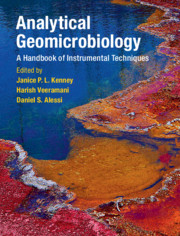Book contents
- Analytical Geomicrobiology A Handbook of Instrumental Techniques
- Analytical Geomicrobiology
- Copyright page
- Contents
- Contributors
- Foreword
- Part I Standard Techniques in Geomicrobiology
- Part II Advanced Analytical Instrumentation
- Part III Imaging Techniques
- Part IV Spectroscopy
- Part V Microbiological Techniques
- Index
- References
Part III - Imaging Techniques
Published online by Cambridge University Press: 06 July 2019
- Analytical Geomicrobiology A Handbook of Instrumental Techniques
- Analytical Geomicrobiology
- Copyright page
- Contents
- Contributors
- Foreword
- Part I Standard Techniques in Geomicrobiology
- Part II Advanced Analytical Instrumentation
- Part III Imaging Techniques
- Part IV Spectroscopy
- Part V Microbiological Techniques
- Index
- References
Summary
Scanning probe microscopy (SPM) is a suite of related imaging methods, in which variations in the interaction force between a probe and a sample surface are used to generate image contrast. These instruments are incredibly sensitive; they can measure forces on the order of those required to break physical and chemical bonds, and under the most optimal conditions, atomic-scale resolution can be achieved. Although SPM is still primarily used for imaging, it is increasingly being used to measure nanoscale properties and interaction forces. This chapter serves as an introduction to the fundamentals of SPM and to the most prevalent methods needed for the investigation of mineral–microbe interactions.
- Type
- Chapter
- Information
- Analytical GeomicrobiologyA Handbook of Instrumental Techniques, pp. 119 - 212Publisher: Cambridge University PressPrint publication year: 2019



